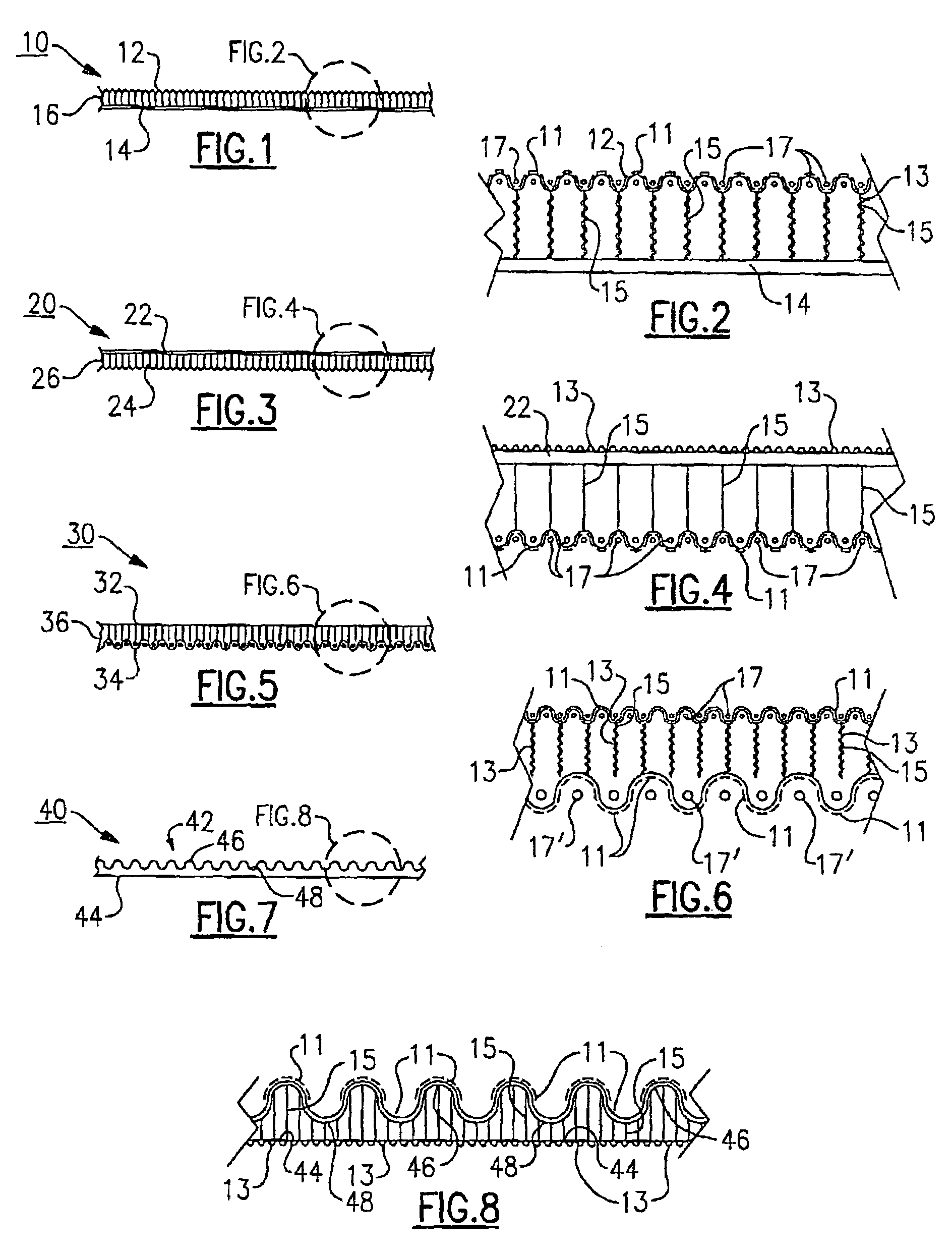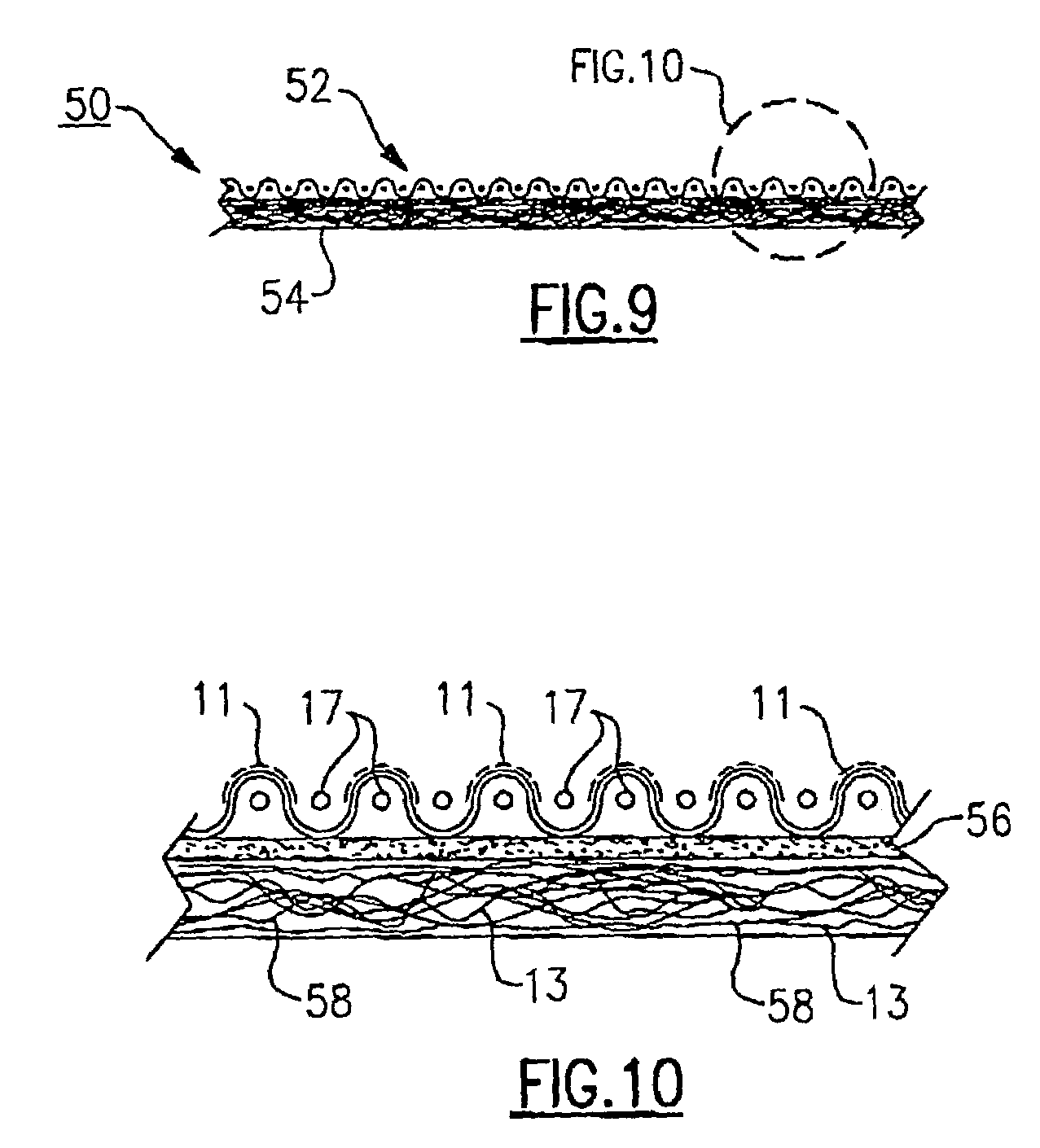Moisture management system
a technology of moisture management and moisture management, applied in the field of footwear and apparel, can solve the problems of difficult to control the moisture or body fluid such as perspiration in shoes, the initial stiffness of shoes made from these materials, and the difficulty of removing perspiration or moisture that collects against the skin, so as to reduce the ability of odor, improve the comfort of the foot, and improve the effect of comfor
- Summary
- Abstract
- Description
- Claims
- Application Information
AI Technical Summary
Benefits of technology
Problems solved by technology
Method used
Image
Examples
example i
[0060]Antimicrobial water repellent and antimicrobial water absorbent treatments are applied to an Air Blando Mesh 100% polyester double-needle bar knit fabric by the following technique. The fabric mesh pores were measured as:
[0061]length—2.8 mm
[0062]width—1.6 mm
[0063]The repellent mix was prepared using the following formulation:
[0064]7600 grams water
[0065]400 grams Barpel 1700
[0066]1.2 grams AlphaSan RC7000
[0067]This mix is added to a standard textile pad unit with one roll partially submerged in the mix and a squeeze roll on top of the submerged roll. On top of the squeeze roll a free-turning rider roll is positioned which functions to press the fabric against the squeeze roll to enhance wet pickup of the mix when the mesh side of the fabric is being kiss-coated with chemistry. The fabric is kiss-coated at 9.4 ft / min line speed and run into an air impingement oven to dry and cure the repellent mix at 300° F. web surface temperature. The calculated web dry solids pickup of the re...
example ii
[0081]The same mesh spacer fabric is used as in the upper / liner fabric of Example I. The repellent mix, process application, and oven speed and temperature are determined as in the upper / liner fabric example. The resultant repellent treatment solids add-on are about 0.13% dry weight of fabric. The treated repellent fabric has repellency ratings of between about 3 and 4.
[0082]The absorbent mix is prepared using the following formulation:
[0083]15000 grams water
[0084]1500 grams Fulatex PD-8081-H
[0085]200 grams Carbowax Sentry 600
[0086]37.5 grams AlphaSan RC7000
[0087]75.0 grams Aerosol OT-75
[0088]78.9 grams Bacote 20
[0089]The absorbent treatment is kiss-coated onto the smooth side of the fabric using the same kiss-coat speed and oven temperature settings as described in the upper / liner fabric example. The absorbent treatment solids add-on is about 0.66% dry weight of fabric. The resultant product has repellency test ratings of between about 3 and 4 and moisture holding capacity of about...
example iii
[0094]A fabric having mesh pores on both sides of the material sold under the tradename 3D Open Blando Mesh III 100% polyester double needle bar knit, by Daewoo International Corporation of Korea is used in this embodiment. The pores are larger on one side than the other. While both mesh sides are kiss-coat repellent treated, the smaller pore side is selected to be on the outside of the shoe. The pore dimensions are:[0095]Large pore side:[0096]length—2.0 mm[0097]width—1.6 mm[0098]Small pore side:[0099]length—1.8 mm[0100]width—1.2 mm
[0101]The repellency mix and process setup are the same as described in the upper / liner fabric Example 1. Repellent treatment dry solids application is measured at 0.13% dry weight of fabric. Repellency ratings of between 3 and 4 are obtained from the resultant treated fabric.
[0102]The absorbent treatment mix and process of application are the same as those described in Example 1. The fabric has 0.2% dry solids pickup in the product. The final product exh...
PUM
| Property | Measurement | Unit |
|---|---|---|
| pore size | aaaaa | aaaaa |
| pore size | aaaaa | aaaaa |
| volume | aaaaa | aaaaa |
Abstract
Description
Claims
Application Information
 Login to View More
Login to View More - R&D
- Intellectual Property
- Life Sciences
- Materials
- Tech Scout
- Unparalleled Data Quality
- Higher Quality Content
- 60% Fewer Hallucinations
Browse by: Latest US Patents, China's latest patents, Technical Efficacy Thesaurus, Application Domain, Technology Topic, Popular Technical Reports.
© 2025 PatSnap. All rights reserved.Legal|Privacy policy|Modern Slavery Act Transparency Statement|Sitemap|About US| Contact US: help@patsnap.com



